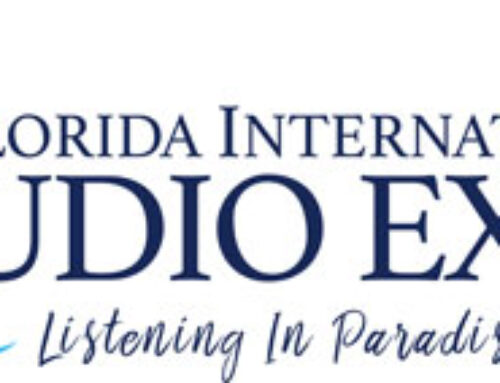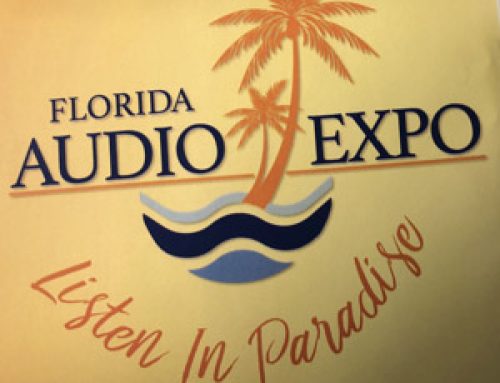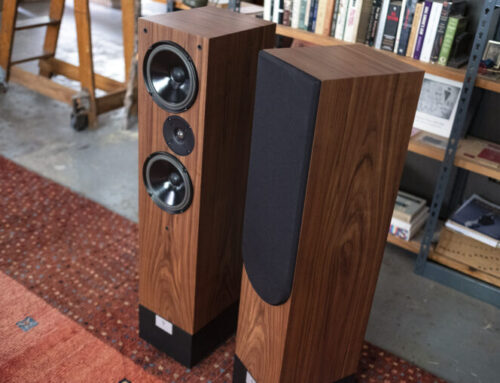 When it comes to buying hi-fi, most of us are forced to take the cost/ performance/value for money triangle into account. It applies when we buy our first system; we know what we’d like but we’re limited to what we can’t quite afford. It applies to our later upgrades. In fact, it applies with a vengeance to upgrades because as soon as we replace something in the system the question of depreciation raises its ugly head. Sure, we don’t think of it like that because to us the upgrade seems cheap: the cost of the new unit less what ever we get for what it’s replacing. It’s a bargain; at least that’s what we tell ourselves, our wife, girlfriend, partner and anybody else who’ll listen. Which is a nice way of deluding ourselves because the actual cost of the new unit is the purchase price plus whatever we’ve lost on the outgoing one. You’ve had the use of it, but don’t think you got it for free. Unless that is, you can upgrade without throwing out your original purchase.
When it comes to buying hi-fi, most of us are forced to take the cost/ performance/value for money triangle into account. It applies when we buy our first system; we know what we’d like but we’re limited to what we can’t quite afford. It applies to our later upgrades. In fact, it applies with a vengeance to upgrades because as soon as we replace something in the system the question of depreciation raises its ugly head. Sure, we don’t think of it like that because to us the upgrade seems cheap: the cost of the new unit less what ever we get for what it’s replacing. It’s a bargain; at least that’s what we tell ourselves, our wife, girlfriend, partner and anybody else who’ll listen. Which is a nice way of deluding ourselves because the actual cost of the new unit is the purchase price plus whatever we’ve lost on the outgoing one. You’ve had the use of it, but don’t think you got it for free. Unless that is, you can upgrade without throwing out your original purchase.
Ever wonder why Naim are so successful? Now you know. It’s all those add on boxes (as well as the fact that if you don’t want the box you’ve got, then somebody else will). Which of course is only any good if you own a Naim system – or a valve amp, because what a Supercap does for a Naim set up, a Border Patrol power supply will do for most of the thermionic alternatives. They even do it in a similar fashion, by grafting on a high quality regulated supply, but there, not surprisingly, the similarities end.
Don’t valve amps have high quality power supplies built in? Not like this they don’t, but to understand why that is we need to look at a couple of typical power supply topologies. In a valve rectified circuit of the type most commonly applied to current valve designs (see diagram below) the degree of regulation is defined by the size of the input capacitor and the size of that capacitor is limited by the low current capability of the valve rectifier. Consequently the regulation of the supply is poor. Why do we want good regulation? Because without it we get the fat ponderous bass, poor dynamics, flat compressed sound and inability to play anything but the simplest passages of music that characterises so many valve amplifiers.

 The obvious alternative is to use solid-state regulation. Solid-state rectifiers can pass plenty of current so the input capacitor can be much bigger (just look at the size of the input capacitor in the circuit diagram below) and the regulation therefore better but solid-state recs are guilty of producing high frequency switching noise which adds metallic edginess to the sound and pollutes the noise floor of the amp robbing the sound of resolution and low level information. Solid state rectifiers are usually used with smoothing resistors, rather than smoothing chokes (check out the Audio Innovations supply) and this approach offers very little high frequency attenuation so any mains borne HF rubbish finds it way into the amplifier and further pollutes the sound. So either of the common approaches suffers from problems when it comes to supplying clean, well-regulated power.
The obvious alternative is to use solid-state regulation. Solid-state rectifiers can pass plenty of current so the input capacitor can be much bigger (just look at the size of the input capacitor in the circuit diagram below) and the regulation therefore better but solid-state recs are guilty of producing high frequency switching noise which adds metallic edginess to the sound and pollutes the noise floor of the amp robbing the sound of resolution and low level information. Solid state rectifiers are usually used with smoothing resistors, rather than smoothing chokes (check out the Audio Innovations supply) and this approach offers very little high frequency attenuation so any mains borne HF rubbish finds it way into the amplifier and further pollutes the sound. So either of the common approaches suffers from problems when it comes to supplying clean, well-regulated power.
But there is an alternative, the valve rectifier- choke regulated supply, and this is the approach that Border Patrol employ. BorderPatrol claim a valve rectifier used in a choke input filter topology gives an ideal combination of regulation, high frequency attenuation and lack of electronic noise. Back in Issue 8 I reviewed their 300B power amp, an unusual two box design, and basically, what we’re talking about here is the power supply section of that amp, but applied to other designs.
At first sight engineering a universal power supply for a whole host of different power amps might seem like an incredibly complex task, however, it’s considerably simplified by the inherent simplicity of valve circuits themselves. Each Border Patrol supply can produce a single regulated voltage either 300, 390 or 430V and applies it to the HT circuit of the amplifier. But given that the vast majority of the more commonly used valves run at between 300 and 430 volts, that means that they can be set to embrace any amp using EL34, 6L6, EL84, 300B or 2A3 output valves, amongst others. As many cheaper amplifiers, such as the Audio Innovations 800 that Gary loaned for listening purposes, employ a single HT supply, that means the whole amplifier benefits from the external regulation supplied by the Border Patrol. That leaves the unit’s own mains transformer with only the heaters to worry about. There are of course output valves that run at far higher voltages, such as the 845 and 211 triodes, and whilst it would be theoretically possible to build a choke regulated supply capable of delivering the thousand or so Volts that they demand, it would be monstrously expensive. Add to that the prospect of passing that kind of voltage down an umbilical and into the amp and it’s easy to understand why Gary is reluctant to follow that course.
So having established the operating context I guess I ought to describe the Border Patrol units in a little more detail. There are two outwardly identical models, the Standard at Ł595 and the MB (answers on a postcard please) at Ł995. The essential difference between the two is that the MB is capable of delivering 350mA of current to the Standard’s 250mA, necessitating a much larger transformer and choke, along with a noticeably heavier overall weight. Owners of the Standard model can have it upgraded to MB status for Ł450, on which more later. Going back to the general schematics that we used earlier, this is how the Border Patrol supplies cut into the circuit.
The first thing to notice is how the GZ37 rectifier valve feeds directly to the large choke which is then responsible for the regulation, making the valve’s current capability irrelevant to the question of quality. Basically, the bigger the choke the better the regulation it provides. Note also that the input capacitor is bypassed in the Audio Innovations. Being a push-pull amplifier the circuit topology actually provides a degree of self-cancellation of power supply ripple and thus requires less smoothing. The same isn’t true of single ended designs, as we shall see. The second thing is that the Border Patrol transformer works at a higher voltage than the original. Like many things that sound good, choke regulation isn’t the most energy efficient way of doing the job, which helps explain why you don’t find choke regulated supplies fitted as standard (except in the aforementioned Border Patrol amp and the Pure Music amps reviewed in Issue 12). They need big transformers, large chokes and big boxes to put them in. All of which are expensive. Add to that the fact that the chokes are prone to mechanical noise and create huge hum fields and it should be obvious that it’s far from straight-forward to get the best out of the technology, requiring considerable skill and patience to deliver the full potential.
In use the donor amp is fitted with a hard-wired umbilical which is connected via a substantial locking socket to the Border Patrol unit. As well as carrying the regulated HT back to the amp, this wire also carries voltage from the amp’s heater supply to the Border Patrol, where it operates the main power relay.
The benefit of this is two fold: it provides remote switch on for the supply meaning it can be tucked away, but more importantly it also makes it impossible for HT to reach the valves without heater voltage, thus avoiding potentially disastrous consequences.
Both Border Patrol units are finished in black painted casework with identical silver aluminium front panels. The effect is workmanlike rather than impressive, but then as I mentioned earlier, you’ll probably want to tuck them away anyway.
Gary supplied the power supplies along with the Audio Innovations 800 and Audio Note Meishu amps already described. These were fitted with rear panel switches so that they could be played as standard or connected to either of the Border Patrol supplies. At the same time he delivered the Canary Audio 608 integrated, reviewed elsewhere, with and without the MB power supply, so I won’t dwell on that here. However, it should be noted that the Border Patrol supplies are simply a blood transfusion for ageing valve amps. Whilst they’ll transform both vintage (Leak, Radford) and valve renaissance designs (Croft, Audio Innovations and Art Audio) they are equally at home with and just as applicable to brand new purchases, either when you buy them or as an upgrade.
 We started listening with the AI 800, a fairly standard ultra-linear EL34 design, remembered chez Gregory mainly for its easy, open midrange rather than as an outstanding amp in its own right. The kind of product whose school report might have read “polite enough but really could do better”. And how! Adding the BP Standard PSU brought immediate gains in almost every aspect of performance: greater transparency, a blacker, quieter background, better separation, better focus and crisper, wider dynamics. The soundstage was clearer and much more coherent, the playing was tighter and the performance musically and rhythmically more coherent. Playing ‘The Thing You Love (Is killing You…) (Dolly Varden The Dumbest Magnets) the individual instruments and voices each took on a more separate and identifiable character: the guitar placed stage-right suddenly grows a body and harmonic complexity, the tambourine becomes a ring of distinct rattles rather than an irritating tizz. But the really important thing is that despite the increased colour and separation, musically speaking the band pulls in closer together. The chemistry in the performance, the players playing off of each other, the careful interweaving of the two voices becomes clearer and stronger. Diane Christiansen’s voice loses the edge and grain that characterised the performance of the standard amp. Now it was smooth and direct and communicative, singing straight to you.
We started listening with the AI 800, a fairly standard ultra-linear EL34 design, remembered chez Gregory mainly for its easy, open midrange rather than as an outstanding amp in its own right. The kind of product whose school report might have read “polite enough but really could do better”. And how! Adding the BP Standard PSU brought immediate gains in almost every aspect of performance: greater transparency, a blacker, quieter background, better separation, better focus and crisper, wider dynamics. The soundstage was clearer and much more coherent, the playing was tighter and the performance musically and rhythmically more coherent. Playing ‘The Thing You Love (Is killing You…) (Dolly Varden The Dumbest Magnets) the individual instruments and voices each took on a more separate and identifiable character: the guitar placed stage-right suddenly grows a body and harmonic complexity, the tambourine becomes a ring of distinct rattles rather than an irritating tizz. But the really important thing is that despite the increased colour and separation, musically speaking the band pulls in closer together. The chemistry in the performance, the players playing off of each other, the careful interweaving of the two voices becomes clearer and stronger. Diane Christiansen’s voice loses the edge and grain that characterised the performance of the standard amp. Now it was smooth and direct and communicative, singing straight to you.
Now this isn’t a subtle change in performance, or a musically trivial one. It isn’t cosmetic or a question of taste. It cuts right to the heart of the amp’s function and creates better, more credible music. Substitute the MB PSU in place of the standard model and you extend that tendency even further. The bass gains additional authority, you can hear the bottom of the bass drum and guitar now, rooting their notes with a proper foundation. More importantly, the sound grows in temporal sophistication. Now it’s the band that defines the pace and attack of the song, controlling events and their destiny.
If I was impressed by the performance on the Innovations amp, it did nothing to prepare me for the transformation wrought on the Audio Note Meishu, a Ł3500 single-ended integrated running one 300B per channel. In stock form this amp could only be described as disappointing. The musical picture it paints is grey, flat and disjointed, with no separation to talk of and no dynamic discrimination. The overall effect is congested and messy, exacerbated by a splashy tendency and very poor control: All in all a bit of a sonic disaster area.
Adding the BP Standard PSU brought about a Cinderella makeover of the kind that day-time TV producers can only dream about. It was as if the milling herd of musical notes had been rounded up and sent off in a single direction. Now the music had a sense of unified energy and purpose. Individual instruments and voices were properly separate and took on something approaching their real colour. All of a sudden the rhythm and pace of the music hove into view like a ship out of the fog and we were off and running. Diane Christiansen’s acerbic delivery regained its sardonic twist, the musicians started to actually play together. In fact, it’s difficult to overstate the magnitude of this improvement. Any Meishu owners out there would be shocked to the core: the designer should seek a very, very dark room.
Once again the MB PSU extends the tendency, bringing authority and definition at the frequency extremes to the extent that you could even follow bass lines (an impossibility with the amp in standard trim). Don’t assume that because the description is rather glib this is any less important than what the Standard model achieves. It is actually even more fundamental, with the music gaining a solid foundation and temporal base. The end result is the ability to convince and transport the listener, which is what really good hi-fi is all about. There’s no law of diminishing returns here, but the good news is that if you’ve invested in the Standard supply you can always have it upgraded to MB status at a later date.
Why the BP supplies should have such a staggering effect on the Meishu is open to question. Gary believes that it reflects the fact that the inherent simplicity of single-ended designs allows you to hear the power supply that much more clearly: Certainly, the evidence of his own 300B amp (reviewed in Issue 10) supports that view. In the case of the Meishu they succeed in turning a very nasty, soggy mess into something very respectable indeed, averting the necessity for replacement, saving you from financial disaster and a stricken conscience. I mean, who are you going to sell it to?
The performance of the Border Patrol supplies is impressive indeed both with single-ended and push-pull designs. Because they add value to an existing unit their return on outlay is even higher, easily outperforming more conventional upgrades in monetary as well as sonic terms. Like all modifications they’ll invalidate the guarantee on the existing amplifier, something to consider if you are purchasing it brand new. However, in that case I’d talk to your dealer about taking that on. After all, it’s in his interest to make the sale. The only other consideration is that the modification should be undertaken by one of Border Patrol’s qualified dealers: HT is no place for enthusiastic DIY! With those two provisos dealt with I can’t recommend the Border Patrol power supplies highly enough. Well thought out and executed, they represent a perfect way of realising the hidden potential inherent in a literally thousands of systems out there. If you’re using a valve amp and you’re looking for an upgrade: if you’re using a valve amp and you’d like to hear what it can really do: if you’re using a valve amp and you’re just down right sceptical: give Border Patrol a call and arrange a demonstration. I’d be surprised if you’re only surprised: shocked is generally nearer the mark.
Given the loss to depreciation inherent in any upgrade, the notion of a universal add-on to improve the performance of basic valve circuits is appealing indeed. BorderPatrol have created a choke filtered unit that will replace the HT supply to a wide variety of circuits and output valves. The benefits have to be heard to be appreciated. The modification is straight forward and reversible, although to date no one has asked for it to be removed once they’ve heard the results. Cost effective engineering to extend the life and performance of existing amplifiers.
Roy Gregory Hi-Fi+ Jan 02 EDITORS CHOICE
Hi-Fi+ 2001 PRODUCT OF THE YEAR Awards Issue
Click these links for online audioasylum.com review’s and comments by PSU owners. Patrick J (UK) Furry (UK) ‘clicker’ (USA) ‘H2O’ (USA) jdwaudio (USA)




Leave A Comment